
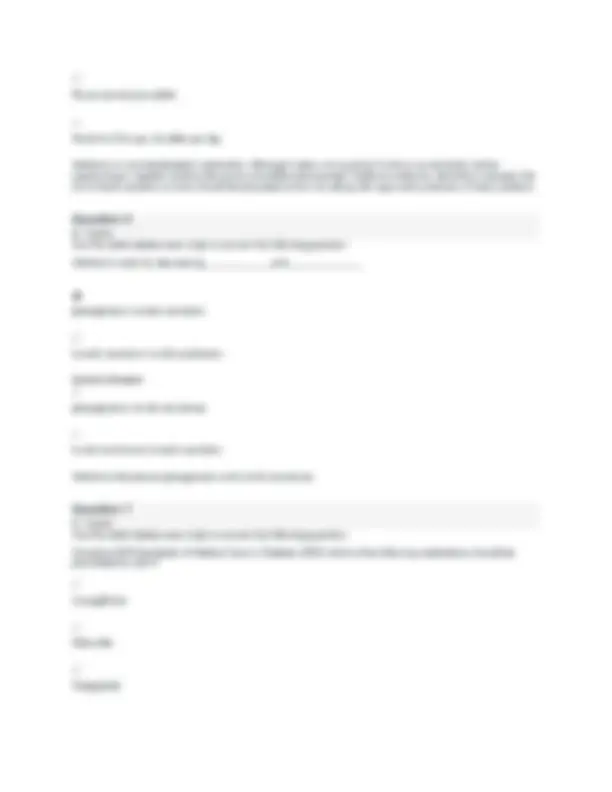
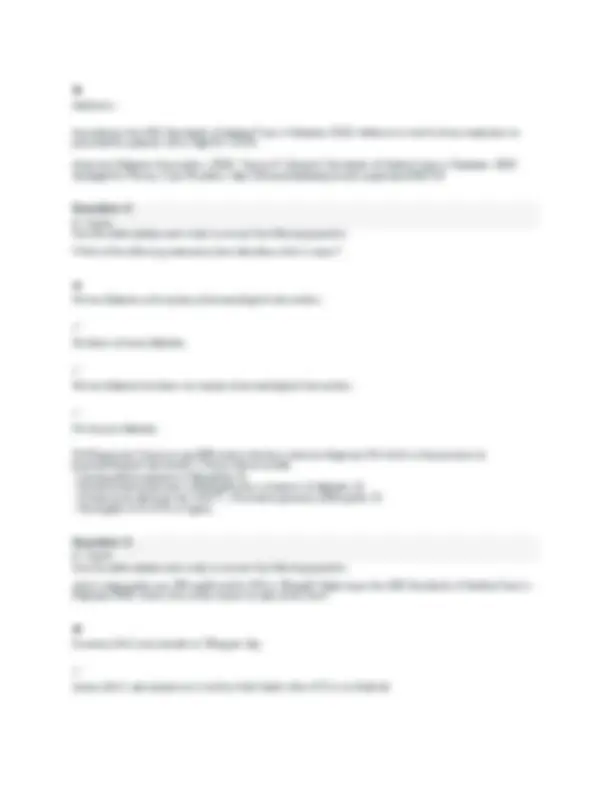
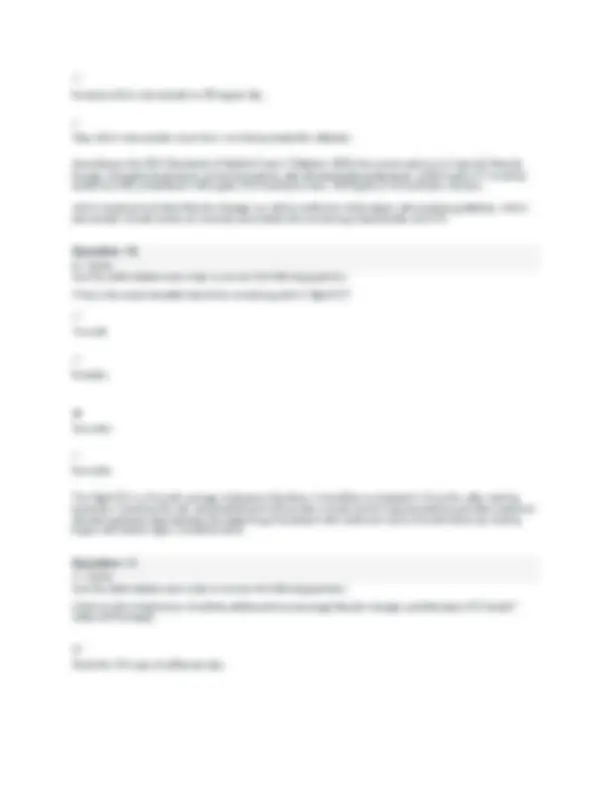
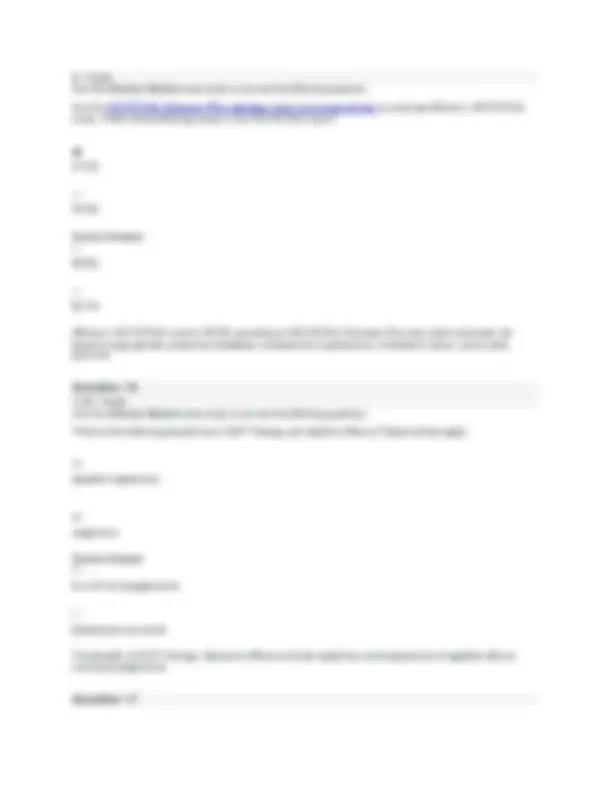
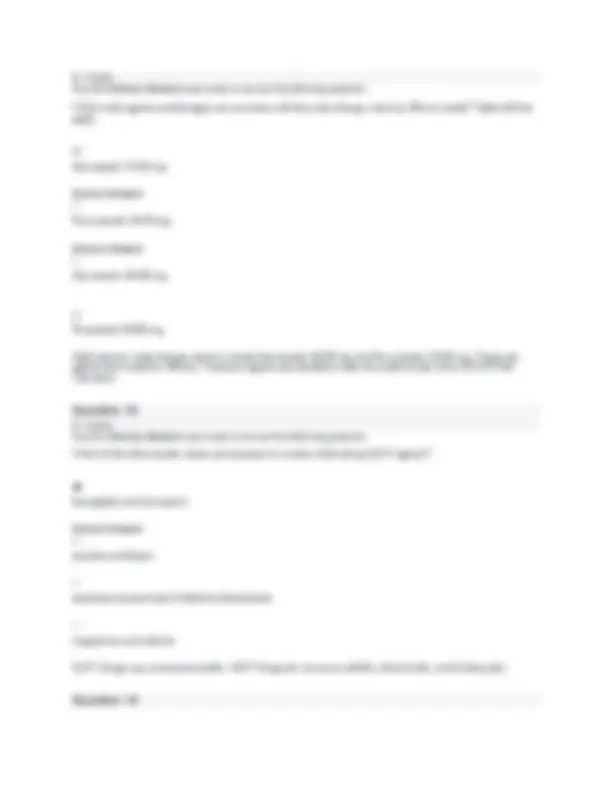
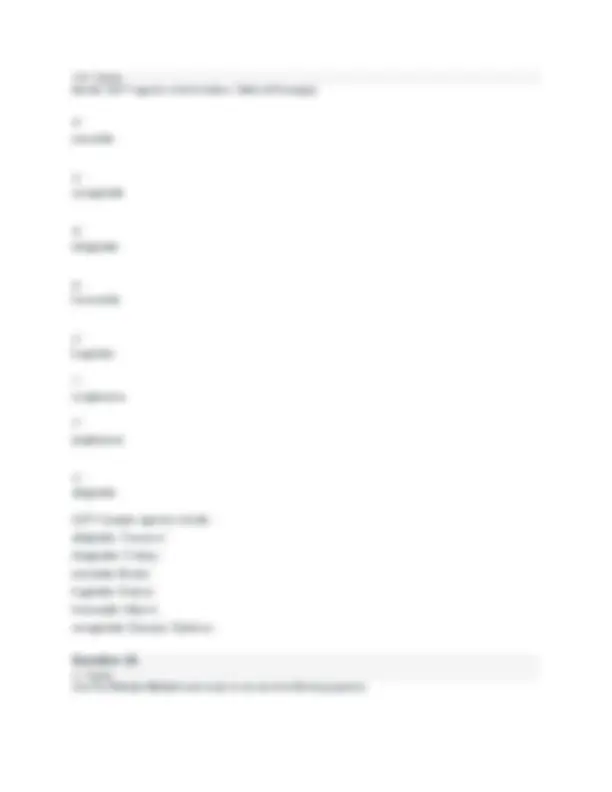
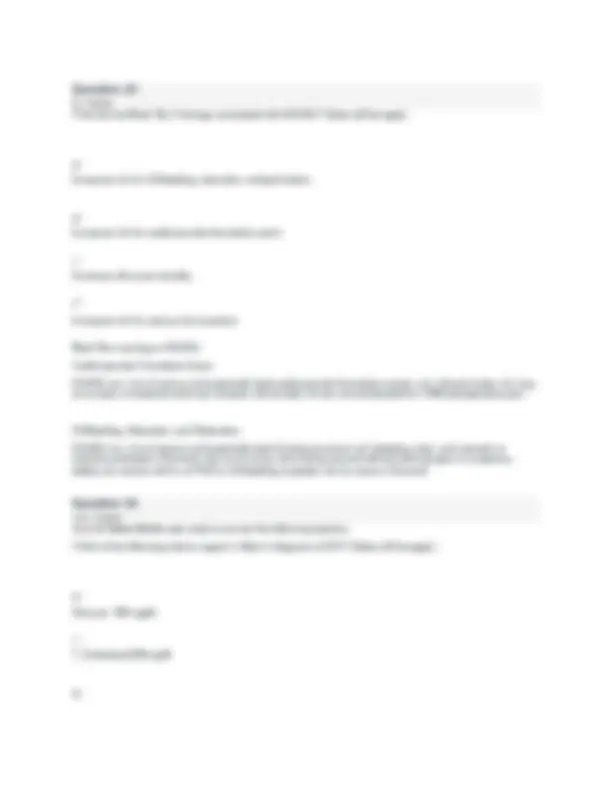
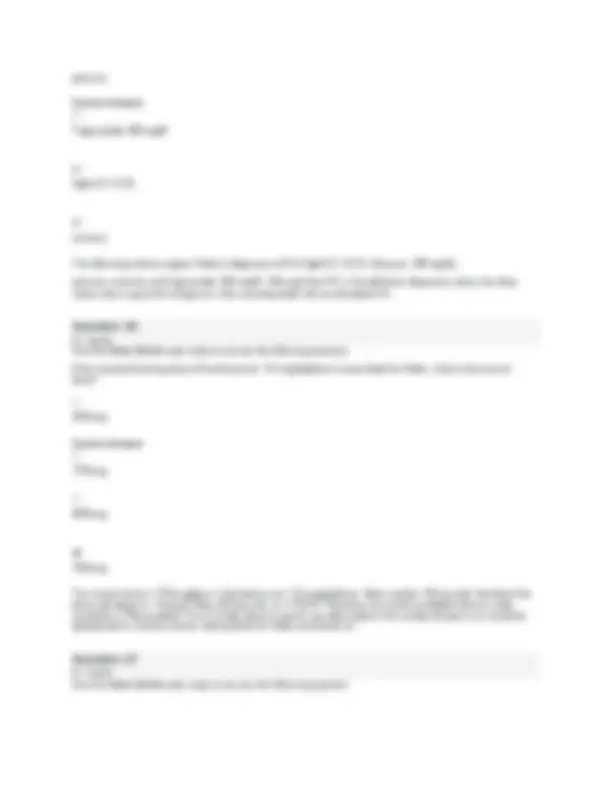
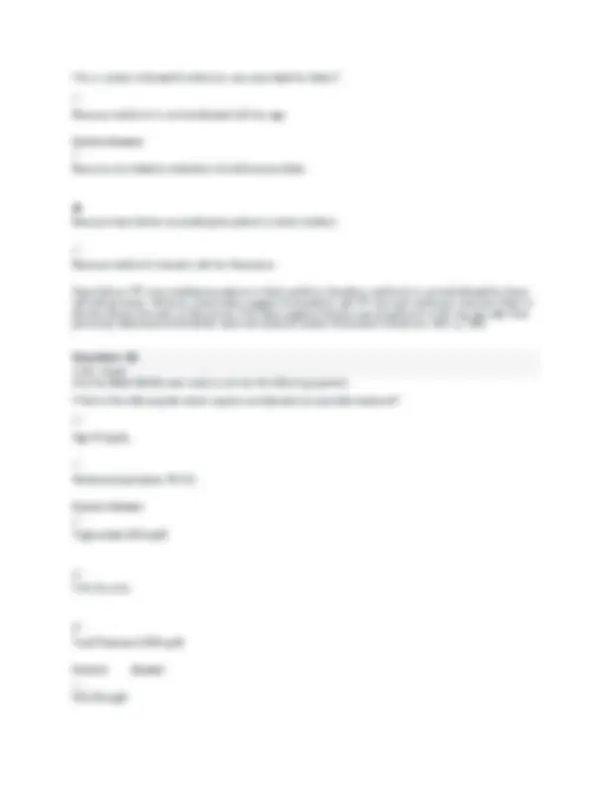
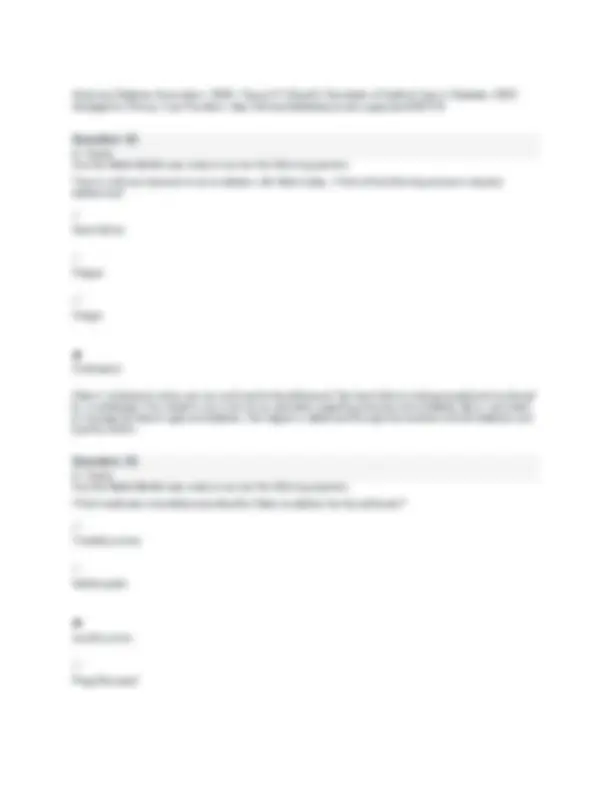
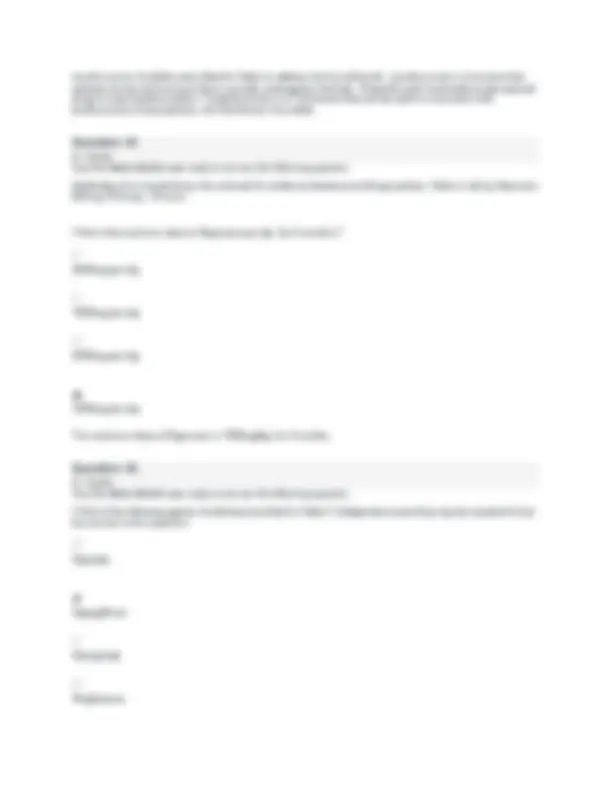
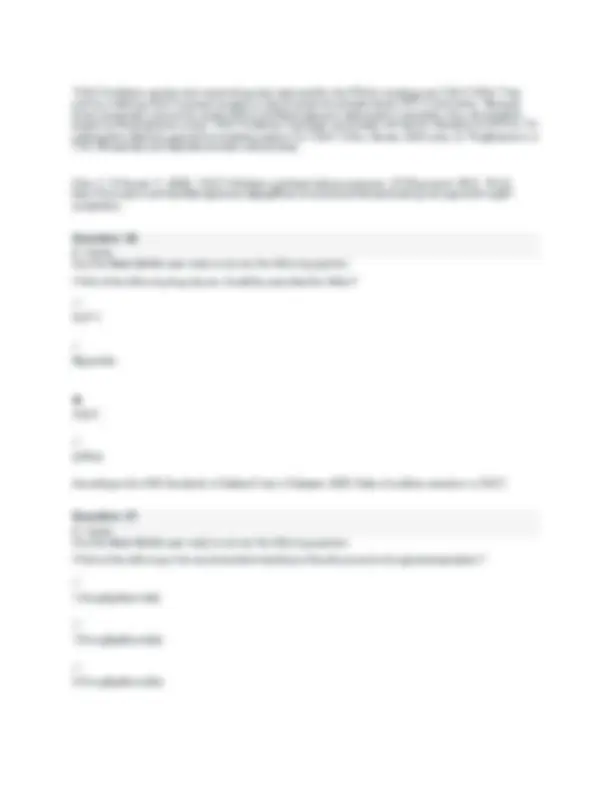
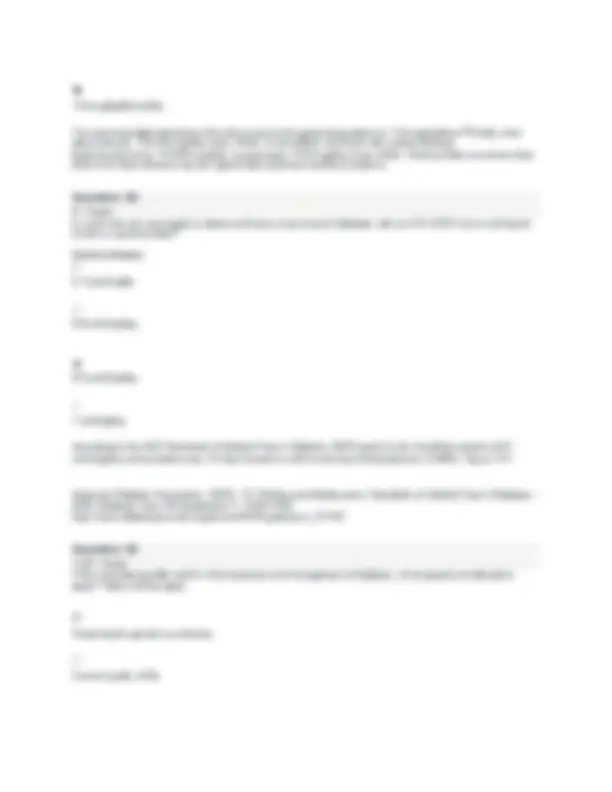
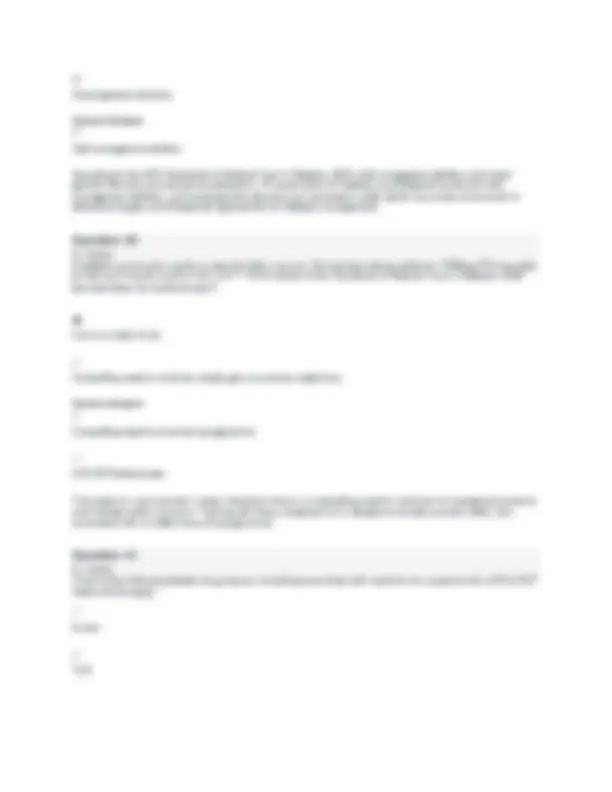
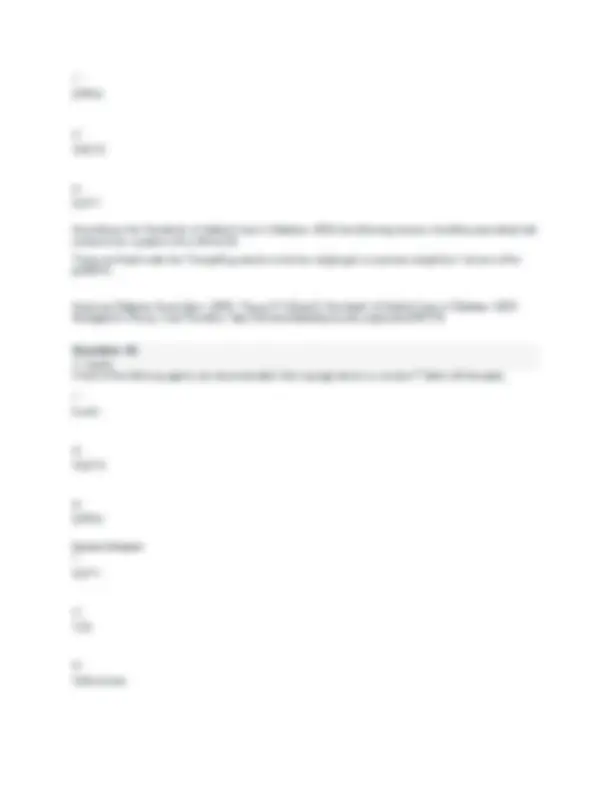
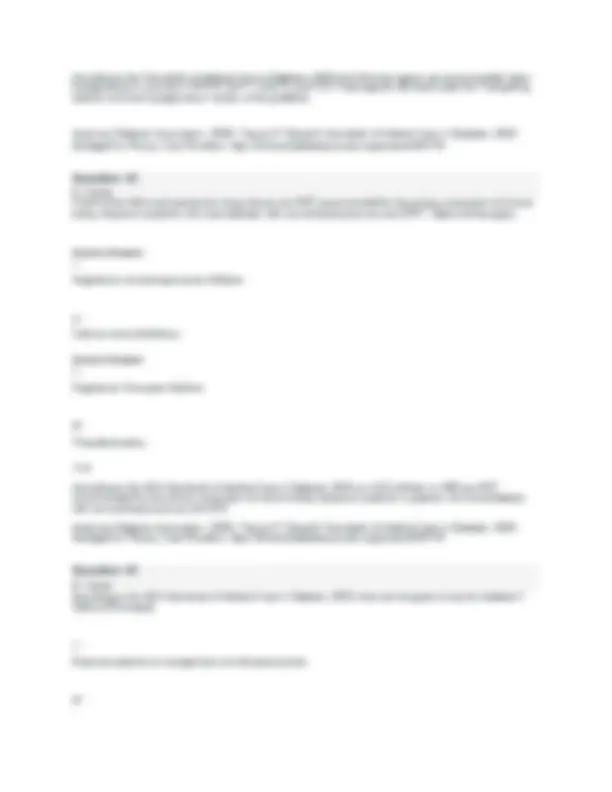
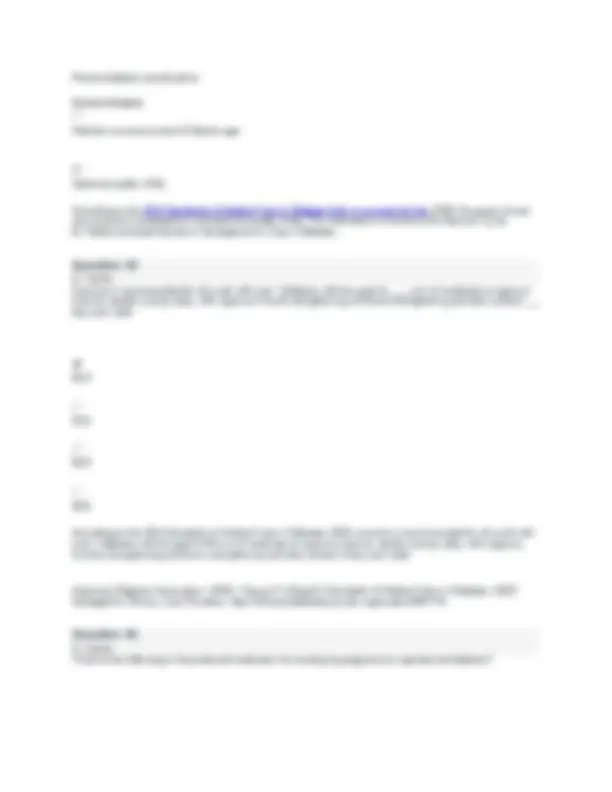
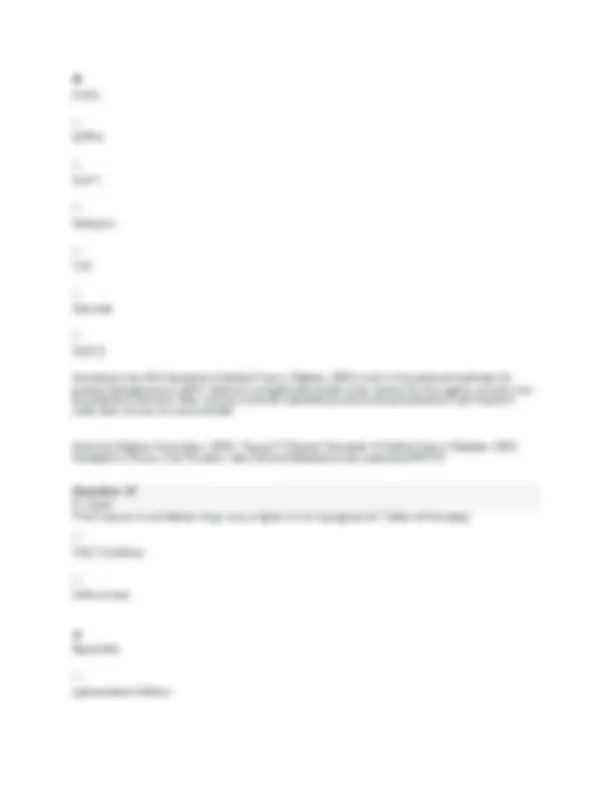
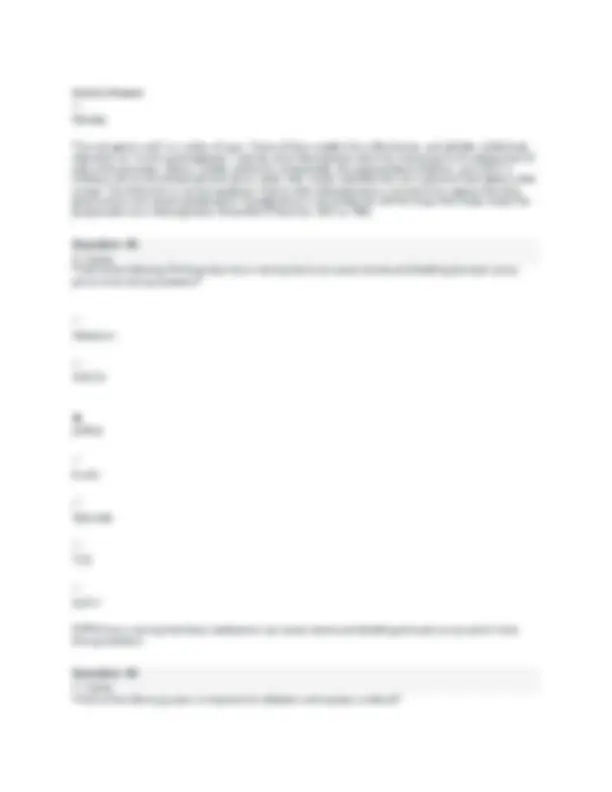
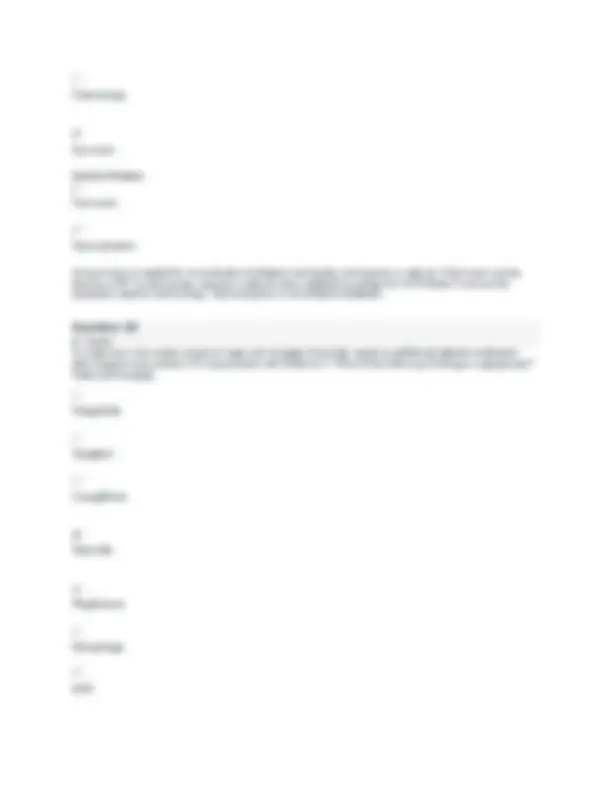
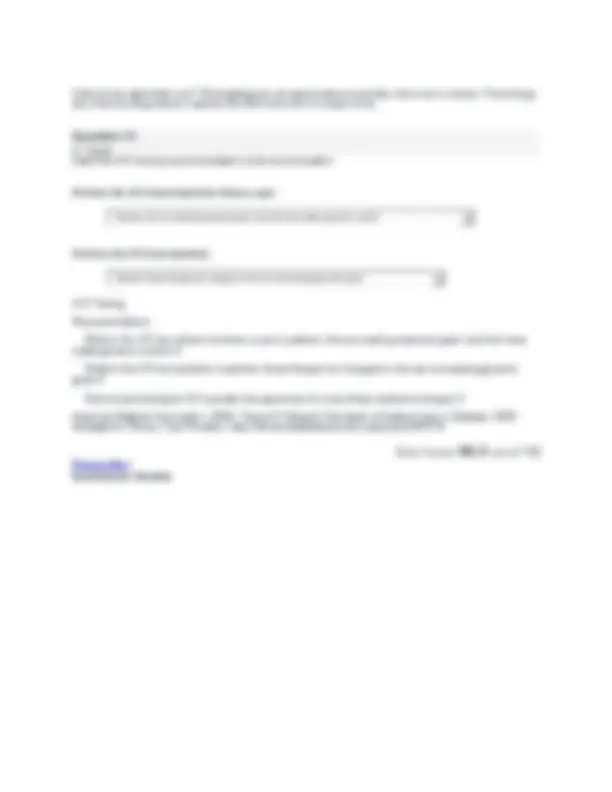


Study with the several resources on Docsity

Earn points by helping other students or get them with a premium plan


Prepare for your exams
Study with the several resources on Docsity

Earn points to download
Earn points by helping other students or get them with a premium plan
Community
Ask the community for help and clear up your study doubts
Discover the best universities in your country according to Docsity users
Free resources
Download our free guides on studying techniques, anxiety management strategies, and thesis advice from Docsity tutors
A series of questions and answers related to pharmacology for the care of the family. It covers topics such as glucose levels, metformin regimen, lab tests, lifestyle changes, and drug classes. The questions are based on case studies and require the application of pharmacological knowledge to solve them. likely to be useful as study notes or exam preparation for students of nursing or pharmacology.
Typology: Exams
1 / 29

This page cannot be seen from the preview
Don't miss anything!






















I understand the value of doing my own work and learning this skill to support my future independent practice as a nurse practitioner. I understand that while there may be opportunities beyond my faculty’s control to collaborate or share answers with peers, that it would not benefit my own personal and professional growth to do so. I agree to do my own work and take personal responsibility for my learning.
I do not.
I do.
Use the John Jones case study to answer the following question.
Which glucose level equates with a Hgb A1C of 8.1%?
~204 mg/dl
~160 mg/dl
~175 mg/dl
~183 mg/dl
The correct answer is ~ 183mg/ dl. See page 400, Table 48.4, Hemoglobin A1c levels and their corresponding eAG levels for complete information.
Use the John Jones case study to answer the following question.
John calls the office and reports that he is scheduled for diagnostic testing that requires IV contrast for imaging. He inquires if there are concerns with undergoing this procedure while taking his medications. What instructions should be given to John regarding his metformin regimen?
Don’t take the metformin the day of the procedure and for 48 hours afterward.
No special instructions are needed.
Take the metformin the morning of the procedure but don’t take it for 48 hours afterward.
Don’t take the metformin the day of the procedure but resume the following day.
Metformin must be withheld on the day of the procedure and for 48 hours afterward. Serum creatinine levels should be normal before resuming metformin.
Use the John Jones case study to answer the following question.
Which of the following lab test should be evaluated before prescribing metformin?
Complete blood count (CBC)
Complete metabolic profile (CMP)
Lipid Panel
Urinalysis
CMP provides a baseline evaluation for both hepatic and renal function which should be evaluated throughout treatment with metformin.
Use the John Jones case study to answer the following question.
Which behavior in John’s social history poses a potential concern with initiating metformin?
His diet largely consists of fast-food meals. He drinks sweet tea with every meal.
He reports drinking ―a few beers on the weekend during football season‖.
Metformin
According to the ADA Standards of Medical Care in Diabetes-2020, Metformin is the first-line medication to prescribe for patients with a HgbA1C >6.5%.
American Diabetes Association. (2020). Figure 9.1 [Graph]. Standards of Medical Care in Diabetes— 2020 Abridged for Primary Care Providers. https://clinical.diabetesjournals.org/content/38/1/
Use the John Jones case study to answer the following question.
Which of the following statements best describes John’s status?
He has diabetes and requires pharmacological intervention.
He does not have diabetes.
He has diabetes but does not require pharmacological intervention.
He has pre-diabetes.
DM Diagnostic Criteria on pg 398 reviews the four criteria to diagnose DM which is the precursor to pharmacological intervention. These criteria include:
Use the John Jones case study to answer the following question.
John’s triglycerides are 260 mg/dl and his HDL is 35mg/dl. Referring to the ADA Standards of Medical Care in Diabetes-2020, what is the correct action to take at this time?
Increase John’s atorvastatin to 20mg per day.
Leave John’s atorvastatin as is and re-check lipids when A1C is re-checked.
Increase John’s atorvastatin to 40 mg per day.
Stop John’s atorvastatin since he is now being treated for diabetes.
According to the ADA Standards of Medical Care in Diabetes-2020, the correct action is to intensify lifestyle
therapy and optimize glycemic control for patients with elevated triglyceride levels (≥150 mg/dL [1.7 mmol/L]) and/or low HDL cholesterol (<40 mg/dL [1.0 mmol/L] for men, <50 mg/dL [1.3 mmol/L] for women).
John's treatment includes lifestyle changes as well as metformin which aligns with practice guidelines. John’s atorvastatin should remain as currently prescribed with monitoring of lipid profile and A1C.
Use the John Jones case study to answer the following question.
What is the recommended interval for monitoring John’s HgbA1C?
1-month
6-weeks
3-months
6-months
The HgbA1C is a 3-month average of glucose; therefore, it should be re-checked in 3 months after starting treatment. Checking this lab value beforehand will provide a mixed result of glucose before and after treatment. Monitoring blood sugar between the beginning of treatment with metformin and a 3 month follow up, fasting finger stick blood sugars should be done.
Use the John Jones case study to answer the following question.
Which of John’s behaviors should be addressed to encourage lifestyle changes and decrease A1C levels? Select all that apply.
He drinks 3-4 cups of coffee per day.
Alfonso should be started on statin therapy to address his high total cholesterol and low HDL.
True
False
Statin therapy is recommended because of his known diabetes and 10-year risk ≥7.5%. If Alfonso’s LDL is <70mg/dl (1.81 mmol/L), additional factors like lifestyle and risk-benefits may be considered before starting statins.
Identify SGLT2i agents in the list below. Select all that apply.
linagliptin
dapagliflozin
alogliptin
sitagliptin
saxagliptin
canagliflozin
empagliflozin
The Food and Drug Administration (FDA has approved three SGLT2 selective inhibitors for mono, dual, and triple therapy: canagliflozin (Invokana®), dapagliflozin (Farxiga®), and empagliflozin (Jardiance®)
Use the Alfonso Giuliani case study to answer the following question.
Use the ASCVD Risk Estimator-Plus calculator (Links to an external site.) to estimate Alfonso’s ASCVD Risk score. Which of the following scores is his ASCVD Risk score?
Correct Answer
Alfonso’s ASCVD Risk score is 46.5% according to ASCVD Risk Estimator-Plus tool, which estimates risk
based on age, gender, presence of diabetes, treatment for hypertension, cholesterol values, and systolic pressure.
Use the Alfonso Giuliani case study to answer the following question.
Which of the following benefits from GLP-1 therapy are helpful to Alfonso? Select all that apply.
appetite suppression
weight loss
Correct Answer
low risk for hypoglycemia
blood pressure control
The benefits of GLP-1 therapy relevant to Alfonso include weight loss and suppression of appetite without causing hypoglycemia.
Identify GLP- 1 agents in the list below. Select all that apply.
exenatide
semaglutide
dulaglutide
lixisenatide
liraglutide
rosiglitazone
pioglitazone
albiglutide
GLP-1 receptor agonists include:
albiglutide (Tanzeum)
dulaglutide (Trulicity)
exenatide (Byetta)
liraglutide (Victoza)
lixisenatide (Adlyxin)
semaglutide (Ozempic, Rybelsus)
Use the Alfonso Giuliani case study to answer the following question.
Which of the following complications may be caused by GLP-1 agents?
diverticulitis
cholecystitis
pancreatitis
Correct Answer
cellulitis
GLP-1 drugs may cause pancreatitis. GLP-1 drugs do not cause cellulitis, diverticulitis, and cholecystitis.
Use the Alfonso Giuliani case study to answer the following question.
Considering Alfonso’s ASCVD risk score, which of the following diabetic drug classes should be considered in addition to metformin?
SGLT2i
Correct Answer
Sulfonylurea
According to the ADA Standards of Medical Care in Diabetes-2020, GLP-1 and SGLT2i drugs are recommended in conjunction with metformin when ASCVD risk predominates. Alfonso meets this criterion with
an ASCVD risk score >40%.
American Diabetes Association. (2020). Figure 9.1 [Graph]. Standards of Medical Care in Diabetes— 2020 Abridged for Primary Care Providers. https://clinical.diabetesjournals.org/content/38/1/
What are the Black Box Warnings associated with NSAIDs? Select all that apply.
Increases risk for GI bleeding, ulceration, and perforation
Increases risk for cardiovascular thrombotic event
Increases all-cause mortality
Increases risk for serious skin reactions
Black Box warning on NSAIDs:
Cardiovascular Thrombotic Event
NSAIDs incr. risk of serious and potentially fatal cardiovascular thrombotic events, incl. MI and stroke; risk may occur early in treatment and may increase with duration of use; contraindicated for CABG perioperative pain
GI Bleeding, Ulceration, and Perforation
NSAIDs incr. risk of serious and potentially fatal GI adverse events incl. bleeding, ulcer, and stomach or intestine perforation; GI events may occur at any time during use and without warning signs or symptoms;
elderly pts and pts with hx of PUD or GI bleeding at greater risk for serious GI events
Use the Helen Smith case study to answer the following question.
Which of the following criteria support’s Helen’s diagnosis of DM? (Select all that apply)
Glucose: 189 mg/dL
T.Cholesterol 240 mg/dl
polyuria
Correct Answer
Triglycerides 260 mg/dl
HgbA1C: 9.2%
nocturia
The following criteria support Helen’s diagnosis of DM, HgbA1C: 9.2%, Glucose: 189 mg/dL,
polyuria, nocturia, and triglycerides 260 mg/dl. Although the A1C is the definitive diagnostic value, the other
values also support this diagnosis when accompanied with an elevated A1C.
Use the Helen Smith case study to answer the following question.
If the standard starting dose of levothyroxine 1.6 mcg/kg/dose is prescribed for Helen, what is the correct dose?
200mcg
Correct Answer
175mcg
300mcg
150mcg
The correct dose is 175mcg/dose. Calculations are 1.6 mcg/kg/dose. Helen weighs 242 pounds; therefore the dose calculation is 1.6mcg/110kg (242 pounds) or =175.63. Therefore, the closest available dose to order would be a 175mcg tablet. This is a high dose to start for an older patient with cardiac disease so it would be appropriate to choose a lower starting dose for Helen and titrate up.
Use the Helen Smith case study to answer the following question.
ALT (alanine aminotransferase): 18 U/L
LDL 120mg/dl
AST (aspartate aminotransferase): 20
Hct 48%
Free T4 0.2 ng/dl
The following lab values require consideration for possible treatment as they are not within normal limits:
Total Cholesterol 240 mg/dl
HDL 35 mg/dl
LDL 120mg/dl
Triglycerides 260 mg/dl
TSH 24 mU/L
Free T4 0.2 ng/dl
Use the Helen Smith case study to answer the following question.
What is the daily maximum dose of levothyroxine?
700mcg/day
500mcg/day
300mcg/day
1000mcg/day
Levothyroxine has a maximum dose of 300 mcg/day.
Use the Helen Smith case study to answer the following question.
Which of the following medical conditions will determine Helen’s diabetes treatment regimen?
Obesity
Osteoarthritis
Dyslipidemia
Heart Failure
According to the ADA Standards of Medical Care in Diabetes-2020, specific treatment for patients with heart failure is warranted. Dyslipidemia, obesity, and osteoarthritis are not determining factors for treatment according to these guidelines.
American Diabetes Association. (2020). Figure 9.1 [Graph]. Standards of Medical Care in Diabetes— 2020 Abridged for Primary Care Providers. https://clinical.diabetesjournals.org/content/38/1/
Use the Helen Smith case study to answer the following question.
Which DM drug class is contraindicated in patients with heart failure?
Sulfonylurea
Biguanide
The ADA Standards of Medical Care in Diabetes-2020notes that TZD drugs should be avoided in patients with heart failure.
Levothyroxine should be prescribed for Helen to address her thyroid levels. Levothyroxine is a hormone that
replaces the thyroid hormone that is normally produced by the body. Propylthiouracil and methimazole are both drugs to treat hyperthyroidism. Triiodothyronine is a T3 hormone that can be used in conjunction with levothyroxine to treat patients with Hashimoto’s thyroiditis.
Use the Helen Smith case study to answer the following question.
Medication lists should always be reviewed for evidence -based prescribing practices. Helen is taking Naproxen 500 mg PO every 12 hours.
What is the maximum dose of Naproxen per day (for 6 months)?
2000mg per day
1000mg per day
2500mg per day
1500mg per day
The maximum dose of Naproxen is 1500mg/day for 6 months.
Use the Helen Smith case study to answer the following question.
Which of the following agents should be prescribed for Helen? (Independent searching may be required to find the answer to this question)
Glipizide
Dapagliflozin
Glimepiride
Pioglitazone
―SGLT2 inhibitors are the most recent drug class approved by the FDA for treating type 2 DM (T2DM). They work by inhibiting SGLT2 transport proteins in the proximal convoluted tubule (PCT) in the kidney. Because these transporters account for nearly 90% of all filtered-glucose reabsorption in the body, they are excellent targets for blood-glucose control. SGLT2 inhibitors have been associated with HbA1c reductions of 0.5% to 1%,
making them effective second-line treatment options for T2DM‖ (Chim, Newaz, 2020, para. 3). Pioglitazone is a TZD, Glimepiride and Glipizide are both sulfonylureas.
Chim, C. & Newaz, S. (2020). SGLT2 Inhibitors and heart failure outcomes. US Pharmacist. 45(2): 18-22. https://www.ajmc.com/view/fda-approves-dapagliflozin-to-treat-heart-failure-breaking-new-ground-in-sglt2-
competition
Use the Helen Smith case study to answer the following question.
Which of the following drug classes should be prescribed for Helen?
Biguanide
SGLTi
DPP-4i
According to the ADA Standards of Medical Care in Diabetes-2020, Helen should be started on a SGLTi.
Use the Helen Smith case study to answer the following question.
Which of the following is the recommended initial dose of levothyroxine for the general population?
1.2mcg/kg/dose daily
1.8 mcg/kg/dose daily
2.0 mcg/kg/dose daily